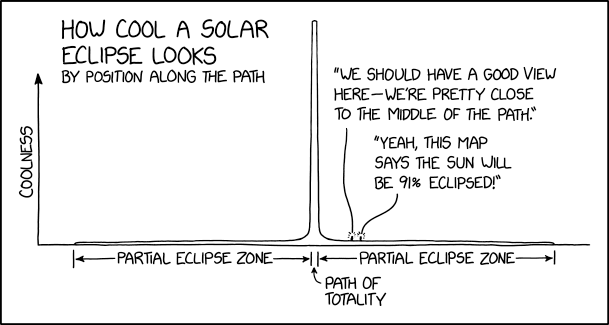While promoting Conan O’Brien Must Go, the talk show host and writer stopped by the First We Feast studio to partake of some spicy wings. After a pre-tasting checkup with his doctor, he sailed effortlessly through every heat level while chatting about his new travel series, his experiences as a late-night host, and the behind-the-scenes antics in the studio.

I recently found this awesome group called "Altered Moments," where people share their re-created "Precious Moments" ceramic collectible figurines. Do you remember those Precious Moments figurines? They were super popular in the 1980s (at least in my small Southern town), looked like tiny overly cute children with giant eyes, and often featured Christian symbols like angels, crosses, and Bibles. — Read the rest
The post "Altered Moments" turn sweet "Precious Moments" figurines into their dark alter egos appeared first on Boing Boing.

If you intend to see the Netflix series “The Three Body Problem” or you want to read the Hugo-winning story from Chinese author [Cixin Liu], then you should probably bookmark this post and stop reading immediately. There will be some mild spoilers. You have been warned.
While the show does have some moments that will make your science brain cringe, there is one scene that shows a computer that could actually be built. Would it be practical? Probably not in real life, but in the context provided by the show, it was perfectly feasible. It could have, however, been done a little better, but the idea was — like many great ideas — both deceptively simple and amazingly profound. The computer was made of human beings. I’m not talking like Dune’s mentats — humans with super brains augmented by drugs or technology. This is something very different.
Background
This is your last chance. There are spoilers ahead, although I’ll try to leave out as much as I can. In the story, top scientists receive a mysterious headset that allows them to experience totally immersive holodeck-style virtual reality. When they put the headset on, they are in what appears to be a game. The game puts you in a historical location — the court of Henry VIII or Ghengis Kahn. However, this Earth has three suns. The planet is sometimes in a nicely habitable zone and sometimes is not. The periods when the planet is uninhabitable might have everything bursting into flames or freezing, or there might not be sufficient gravity to hold them on the planet’s surface. (Although I’ll admit, I found that one hard to grasp.)
Apparently, the inhabitants of this quasi-Earth can hibernate through the “chaotic eras” and wait for the next “stable era” that lasts a long time. The problem, as you probably know, is that there is no general closed-form solution for the three-body problem. Of course, there are approximations and special cases, but it isn’t easy to make long-term predictions about the state of three bodies, even with modern computers.
The Great Kahn
Of course, the court of Ghengis Kahn didn’t have computers, but they could have, as the show demonstrated. In one scene, some players of the game are passing by row after row of soldiers.
At first, you think it is just a show of military force for some reason. However, two other players announce that they can solve the riddle of when the next chaotic era will arrive and how long it will last. You can see that the field of soldiers is vast, and there are towers strategically placed.

On a command to “run” a program, the soldiers begin twisting poles they are holding with large cards on them. One side of the card is white, and the other black.
It doesn’t take much to realize that one color is a binary 1, and the other is a binary 0. The soldiers each follow rules to form logic gates. You can assume the towers gather up results and send them to other towers. Riders on horseback carry the results up to the player who is with the Kahn.
Practicality
This could obviously be made to work. Each soldier’s rules would determine what kind of logic gate it was. For example: look at the soldier to your right and your left. If both of their cards are black, show your black card. Otherwise, show your white card. There’s an OR gate. An AND gate or an inverter would be just as easy.

Of course, the entire setup looks like an IC die, so in real life, you’d probably have problems getting so many people together and trained. However, this is virtual reality, so it seems about as feasible as making a CPU in, say, Minecraft. It would be easy to write rules for higher-level functions, too. For example, different flip flops, multiplexers, and demultiplexers could be rule-based like in Verilog, instead of made from gates.
There are a few other practical considerations. It isn’t totally clear on the TV show, but it seems like the system is asynchronous. That’s hard to design, so we usually use synchronous designs. I mentioned flip flop rules earlier. It seems like some instructions to the human elements would start with the phrase “When you hear the drum beat…” The drummer, then, would be like a clock.
Of course, on a large FPGA, you have to worry about getting the clock signal to everyone simultaneously and you’d have the same problem here. Perhaps you’d use pipelining to have a local clock that then hands off to a different clock domain. Maybe a mirror on a tower could help synchronize the clocks.
The other problem is that humans make mistakes far more often than digital logic. So, like a relay or quantum computer, it would probably help to detect errors and maybe even make corrections in the system. Of course, we don’t know that it didn’t have that. In the end, the computer didn’t work. However, we don’t know if that was due to error or the general problem of solving the equations numerically. Even today, it takes a lot of CPU power to do that and we can’t imagine the human computer is very fast.
So?
Is this really practical? In theory, yes, although we don’t have enough friends to put together something that big. You might be able to devise a scheme to do it over the Internet, but that doesn’t seem as impressive. Perhaps at the next Supercon, we’ll try to put together a full adder. You could use people as traditional gates or even relays.
True, back in the old days, a “computer” was, in fact, the job of a person who did math to build things like tables. But that is different still. The Three Body Problem computer could take people with little skill, teach them a simple rule, and then get the benefits of a modern digital computer. You just need a tremendous number of people.
We are always fascinated by how, once you understand the concept, you can make a computer from almost anything. So, using this method, fluidic logic, or marbles, people like the ancient Egyptians, Chinese, or Romans could have had computers. What would they have done with them?

Amazon is to end the AI-powered "Just Walk Out" checkout option in its Amazon Fresh stores. It turns out that "AI" means "Actually, Indians" and it isn't working out.
The company's well-known technology lets customers pay for items without standing in line and sends them receipts afterwards.
The post Amazon's AI-powered "Just Walk Out"checkout option turns out to be 1000 workers watching you shop appeared first on Boing Boing.

